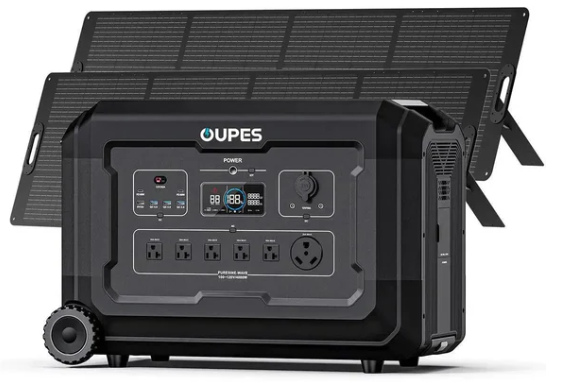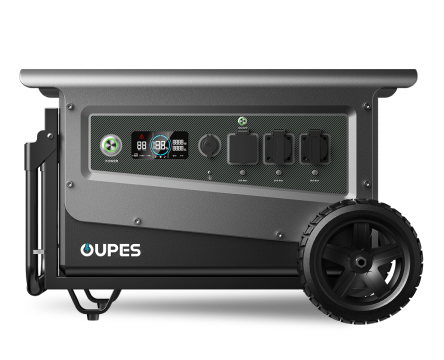
Overview
Earthquakes strike suddenly and often cause widespread infrastructure damage, including long-term power outages. According to the United States Geological Survey (USGS), millions of Americans live in high-risk seismic regions, and a major quake can disrupt electricity for hours, days, or even weeks depending on the severity of the damage.
A solar generator—also commonly referred to as a portable power station paired with solar panels—offers a reliable, quiet, and fuel-free source of backup electricity. Unlike conventional fuel generators, solar systems remain fully operational even when gas stations close or supply chains fail. This makes them an essential part of modern earthquake emergency planning.
Understanding Earthquake Risks
Power Grid Failure Is Extremely Common
Earthquakes frequently damage transmission lines, substations, and underground cables. The Federal Emergency Management Agency (FEMA) notes that electrical restoration can take significantly longer in areas with difficult terrain or extensive structural collapse. A backup power system is not optional—it is a critical survival tool.
Access to Fuel May Be Limited
During major earthquakes, roads may close, fuel deliveries may stop, and gas stations may lose power. Solar generators eliminate fuel dependency because they can be recharged safely and indefinitely using sunlight.
Communication and Medical Needs Become Urgent
Phones, radios, medical devices, and lighting are essential during disasters. Without backup power, these life-sustaining tools become unusable within hours.
Why Solar Generators Are Critical During Earthquakes
1. They Operate Even When the Grid Is Completely Down
Solar generators provide uninterrupted power, functioning independently from damaged electrical infrastructure. This makes them exceptionally valuable in the first 72 hours after a disaster—often the most critical window for survival and communication.
2. Fuel-Free Power When Gas Stations Are Inaccessible
Earthquakes often cause gas stations to shut down due to structural damage, gasoline leaks, or electrical outages. Solar power remains usable as long as sunlight is available.
3. Safe for Indoor Use
Unlike fuel generators, solar generators emit no carbon monoxide, making them safe to operate inside homes, apartments, or shelters. The Centers for Disease Control and Prevention (CDC) reports that CO poisoning is one of the leading causes of death during power outages caused by disasters—solar systems eliminate this risk.
4. Low Maintenance and Always Ready
Fuel generators often fail due to stale gasoline or mechanical issues. Solar generators require no fuel storage, have no combustion engine, and can hold charge for long periods.
5. Rechargeable from Multiple Sources
- Solar panels
- Wall outlet (before an earthquake)
- Vehicle 12V charging
This versatility ensures you can maintain power even when the grid is unstable or unavailable.
Solar Generators vs. Traditional Backup Options
| Backup Option | Advantages | Disadvantages |
|---|---|---|
| Solar Generator | - Safe indoors - No fuel needed - Quiet operation - Renewable charging source - Low maintenance |
- Depends on sunlight - Limited output compared to large gas generators |
| Gas Generator | - Higher continuous output - Runs heavy appliances easily |
- Dangerous indoors - Requires fuel - Loud and high maintenance |
| Power Bank | - Ultra-portable - Good for phones and small devices |
- Cannot power appliances - Limited capacity and utility |
In earthquake scenarios where fuel access is uncertain and indoor safety is crucial, solar generators offer the most stable and practical form of home-based emergency power.
Practical Emergency Use Cases
1. Powering Communication Devices
Phones, radios, and satellite systems become lifelines during emergencies. Solar power ensures they remain operational even when the grid is impaired.
2. Running a Refrigerator or Mini-Fridge
Food spoilage becomes a major concern during outages. Many portable power stations can operate a compact fridge for hours or even days, depending on capacity.
3. Medical Equipment Support
Devices such as CPAP machines, oxygen concentrators, and electronic thermometers require reliable power. A solar generator ensures uninterrupted operation for individuals with medical needs.
4. Emergency Lighting and Safety Tools
Lighting is essential for safety in damaged structures. Solar generators can energize LED lights, flashlights, and motion sensors without risking fire hazards.
5. Charging Power Tools and Repair Equipment
Aftershocks frequently damage homes. Power tools for repairs—such as drills, saws, and battery chargers—can all run from a properly sized solar generator.
How to Choose the Right Solar Generator for Earthquake Preparedness
1. Battery Capacity
A larger battery allows longer operation during multi-day outages. For preparedness, experts recommend at least 1000–2000Wh of storage for essential home needs.
2. Inverter Output
Inverters rated 1000–2000W can power most critical appliances such as refrigerators, fans, and communication devices.
3. Solar Input Capability
A higher solar input (e.g., 800W–2000W) ensures fast recharging during prolonged outages. This is crucial when sunlight availability is limited.
4. Safety Features
Look for LiFePO4 battery chemistry, short-circuit protection, and a reliable Battery Management System (BMS). These features reduce fire risk during structural stress.
5. Portability and Ease of Storage
Earthquake kits should be accessible. Portable solar generators from OUPES are known for compact form factors and ease of deployment.
How OUPES Systems Fit Into Earthquake Preparedness
OUPES portable power stations incorporate LiFePO4 batteries, fast solar recharging, and multiple AC and DC outputs. Their reliability and safety make them suitable for emergency kits designed for both short and long-term outages. They can power refrigeration, lighting, communication equipment, medical devices, and essential home electronics.
While this article remains educational, OUPES serves as an example of how modern solar generators can support earthquake preparedness without relying on fuel-based systems.
FAQ
1. Can a solar generator replace a gas generator during earthquakes?
For essential needs—yes. Solar generators can power communication devices, medical equipment, lighting, and small appliances. However, heavy-duty loads may still require a larger system.
2. How long does a solar generator last during an emergency?
Runtime depends on battery capacity and appliance usage. High-capacity units (1000–3000Wh) can power essential devices for many hours and refrigerators for extended periods.
3. Do solar generators work on cloudy days?
Yes, though charging speed decreases. Most units offer multiple charging methods, including car charging.
4. Is a solar generator safe to use indoors?
Absolutely. Solar generators produce no emissions and are safe in sealed environments, unlike gas generators.
5. Should solar panels be stored or deployed before an earthquake?
Panels should be stored safely indoors. After the quake, deploy them as soon as conditions are safe.




























